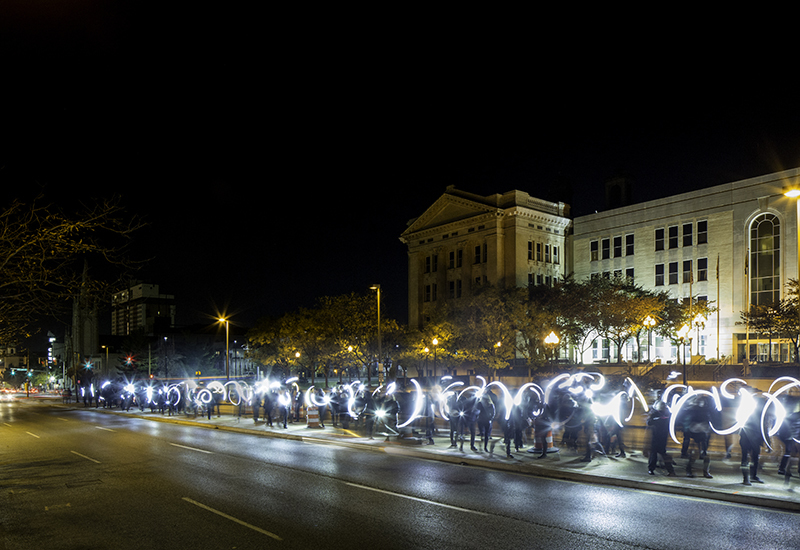
Guerrilla lighting isn’t a term that has gained a lot of traction in the United States, but in Europe, it’s commonplace. The idea is to gather a group of people and illustrate the transformative power that lighting a certain block or street can have in making a place more welcoming, attractive, and fun.
During Light City earlier this month, a group of artists and community activists led by the Neighborhood Design Center (NDC) and the Charles North Community Association—backed by local Dixieland jazz band Sac au Lait—took this concept and ran with it. More than 100 people marched through Station North over the course of the evening, lighting up murals, landmarks, and a median between Calvert and Guilford streets. Moving in a time-lapse style where the flashlights combined together to create a bright beam, they showcased the type of more permanent installations they hope will continue to permeate the area.
The event, which they dubbed “Flash,” caused such a hubbub that observers felt compelled to join in. It served as a kickoff for what will be called Signal Station North, a new multi-stage initiative that hopes to bring more light to the neighborhood.
“The impact of that moment—walking with people in public space in a very joyful way, felt like it captured the spirit of the project,” says Merrell Hambleton, the NDC project manager of Signal Station North. “I think having beautiful and high-quality public space lighting is critical to the future of the district.”
Armed with a $150,000 grant from the National Endowment of the Arts’ (NEA) Our Town program and a match from Central Baltimore Partnership, community leaders and residents hope that this project can contribute to a bigger and brighter Station North. Principle planning for the two-year project began in July, and the plans are set to be introduced to the community in the next few months.
Hambleton and her local collaborators—including Flux Studio, Post Typography, Central Baltimore Partnership, artist advisors, and other neighborhood leaders—are still working out exactly what shape the project will take. But, on a broad scale, they envision using the grant to emphasize public works of art and draw attention to specific blocks with the hope of continuing further activation.
There are three different lighting types they are hoping to implement—something practical, such as a street light, a DIY project that can be replicated by the community, and light-based art installations that will be chosen from an open call to artists interested in contributing.
“We’ve always wanted to have a comprehensive lighting master plan in the heart of the arts and entertainment district in the city,” says David Lapides, head of the Charles North Neighborhood Association. “We have a real vision for the area, and we think it’s vital that the district show cutting-edge lighting.”
Hambleton is quick to caution that this initiative is not going to light up the whole neighborhood, but it is an important step in the right direction.
“There’s no question that more [quality] lighting will increase people’s interest in coming to this space and others in the city,” Hambleton says. “One of the things we’re hoping to learn through the planning process is how the people who are in the district, or come to the district, feel about light.”
The community-minded project also aims to make locals feel safe and visitors more likely to frequent the neighborhood.
“It helps with perception that the area is safe—that is something we battle,” says Ellen Janes, executive director of Central Baltimore Partnership. “And this can go a long way to helping people feel comfortable coming here. We want to create a gathering spot.’
Given the foot traffic that Station North receives, organizers hope the project will serve as a testing ground for how future projects might take shape in other neighborhoods.
“This area has so much activity underway,” Janes says. “So it’s a good place to serve as a lab for how things can be done.”
Those involved stress that it is important that the community, those who live and work here, have input every step of the way. It’s their wants and needs that organizers hope will help shape how this initiative is carried out.
“I really think that in five to 10 years, this neighborhood is going to be the center of the action,” Lapides says. “When things are lit up, people are happier.”